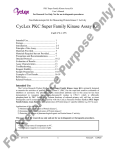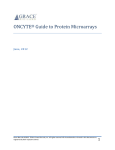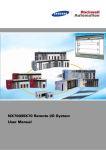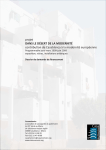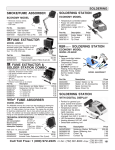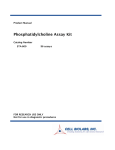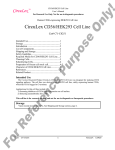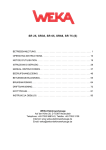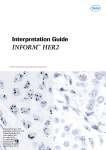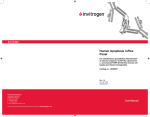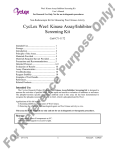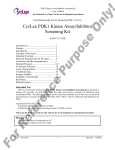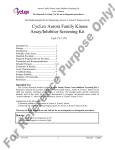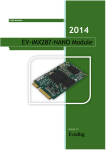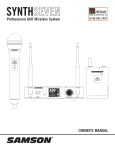Download CY-1175
Transcript
t. uc od ur pr PKC Super Family Kinase Assay Kit User’s Manual For Research Use Only, Not for use in diagnostic procedures ith yo Non-Radioisotopic Kit for Measuring PKC Activity ew CycLex PKC Super Family Kinase Assay Kit ca at th al an u rm se fe rt o th eu Intended Use................................................ 1 Storage......................................................... 1 Introduction.................................................. 2-3 Principle of the Assay.................................. 3-4 Materials Provided....................................... 5 Materials Required but not Provided........... 6 Precautions and Recommendations............. 7 Detailed Protocol......................................... 8-12 Evaluation of Results...................................13 Assay Characteristics...................................13 Troubleshooting...........................................13 Reagent Stability..........................................13 Sample Preparation..................................... 14-15 Example of Test Results............................. 16-18 References................................................... 19 Related Products.......................................... 20 m Cat# CY-1175 re Intended Use nl y! Pl ea se The CycLex Research Product CycLex PKC Super Family Kinase Assay Kit is primarily designed to measure the activities of purified protein kinase C (PKC) for the rapid and sensitive evaluation of inhibitors or activators. The phospho-specific monoclonal antibody used in this assay kit has been demonstrated to recognize the phospho-threonine38 residue in CPI-17, which is efficiently phosphorylated by PKC. Additionally, column fractions of cultured primary cell, cell line, or tissue homogenate can be assayed for PKC activity with the CycLex Research Product CycLex PKC Super Family Kinase Assay Kit if the appropriate dose of PKC inhibitor e.g. H-9 is used. os eO Applications of this kit include: 1) Monitoring the purification of PKC. 2) Screening inhibitors or activators of PKC 3) Detecting the effects of pharmacological agents on PKC activity. Pu rp This assay kit is for research use only and not for use in diagnostic or therapeutic procedures. Storage er en ce • Upon receipt store all components at 4°C. • Don’t expose reagents to excessive light. Fo rR ef Cat#: CY-1175 1 Version#: 151015 t. uc od yo ur pr PKC Super Family Kinase Assay Kit User’s Manual For Research Use Only, Not for use in diagnostic procedures ith Introduction se re fe rt o th eu se rm an u al th at ca m ew Members of the protein kinase C (PKC) family of serine/threonine protein kinases have been implicated in numerous cellular responses in a large variety of cell types. PKC isoenzymes are involved in multiple biochemical processes relevant to cell growth, differentiation, and transformation, and play critical roles in transducing signals from a plethora of extracellular receptors, including those for hormones, neurotransmitters, growth factors, and antigens (1, 2). At present, the PKC family of serine/threonine-specific protein kinases includes eleven known members that are expressed in a variety of tissues and cell types. Based on similarity in primary amino acid sequence and domain structure, the distinct PKC isoenzymes are grouped into three subfamilies. Members of the Ca2+-dependent subfamily are termed conventional, or cPKC, and include PKCα, the two alternatively spliced forms of the β gene, PKC βI and βII, and PKC γ (3-6). These isoenzymes contain three conserved domains, namely, the diacylglycerol-binding C1 domain, which contains two repeats of a cysteine-rich zinc finger-like domain, the phospholipid- and Ca2+-binding C2 domain, and the catalytic C3/C4 domains. Members of the second subfamily, termed novel, or nPKC, are Ca2+-independent for their activity and include PKC δ, ε, η, θ and µ (7-10). The C2-like N-terminal domain of these isoenzymes can bind acidic phospholipids but not Ca2+. A third PKC subfamily termed atypical, or aPKC, includes only two members, PKCζ and ι/λ, that possess a single cysteine-rich domain which cannot bind phospholipids or phorbol esters (7, 11, 12). Regulation of PKC activity is mediated by defined cofactors that interact with specific regions in its regulatory domain (13) as well as transphosphorylation by serine/threonine kinases (14) and autophosphorylation (15). The activation is accompanied by removal of the basic pseudosubstrate region from the kinase domain (16) and may involve the association with specific proteins, termed receptors for activated PKC (17), that were suggested to function as selective scaffolds for activated PKC at discrete subcellular compartments. Distinct PKC isoenzymes exhibit differences in tissue distribution, intracellular localization, and cofactor requirements, suggesting that they are independently regulated through response to discrete ligands, and that they may possess distinct protein substrates (18). It is possible that the specific combination of isoenzymes expressed in a given cell determines the outcome of the PKC-dependent response in that particular cell. ea Measurement of PKC activity er en ce Pu rp os eO nl y! Pl The protocol generally regarded as most sensitive for the quantitative measurement of PKC activity involves incubation of the PKC sample with substrate, either a natural or synthetic polypeptide (such as a histone III-S), in the presence of Mg2+and 32P-labeled ATP. The reaction is terminated by "spotting" a sample onto a phosphocellulose P81 filter paper disc, followed by washing extensively to remove unincorporated radiolabel and the incorporated radioactivity on P81 filter is counted. While sensitive, this method is labor-intensive, generates hazardous radioactive waste, and depends on a radioisotope of short half-life. It is particularly unsuitable when kinase assays are only performed on an infrequent basis. The CycLex Research Product CycLex PKC Super Family Kinase Assay Kit uses a peroxidase coupled anti-sequence-specific phosphoserine monoclonal antibody as a reporter molecule in a 96-well ELISA format. This assay provides a non-isotopic, sensitive and specific method to detect PKC activity. The CycLex Research Product CycLex PKC Super Family Kinase Assay Kit is designed to accurately determine the presence and relative amount of PKC activity in purification column fractions, and for the non-isotopic kinetic analysis of PKC activity. Careful attention to extraction methods and the assay protocol will provide the investigator with a reliable tool for the evaluation of PKC. The CycLex PKC Super Family Kinase Assay Kit can be used for measuring most of recombinant PCK isozymes including all cPKCs as well as aPKCs and several nPKC, e.g. PKC δ, ε and θ (see page 18). Fo rR ef Cat#: CY-1175 2 Version#: 151015 t. uc od yo ur pr PKC Super Family Kinase Assay Kit User’s Manual For Research Use Only, Not for use in diagnostic procedures ith Principle of the Assay er en ce Pu rp os eO nl y! Pl ea se re fe rt o th eu se rm an u al th at ca m ew The CycLex Research Product CycLex PKC Super Family Kinase Assay Kit is a single-site, semi-quantitative immunoassay for PKC activity. Plates are pre-coated with a substrate corresponding to recombinant CPI-17 (Protein kinase C-potentiated inhibitor protein of 17kDa), which contains threonine38 residues that can be efficiently phosphorylated by PKC. The detector antibody is AK-1F11, an antibody that specifically detects only the phosphorylated CPI-17 threonine38. The CycLex Research Product CycLex PKC Super Family Kinase Assay Kit might be used to determine the presence of PKC activity in purification column fractions, or to follow the kinetics of a purified PKC as well as screening PKC inhibitor or activator. To perform the test, the sample is diluted in Kinase Buffer, pipetted into the wells and allowed to phosphorylate the bound substrate in the presence of Mg2+ and ATP. The amount of phosphorylated substrate is measured by binding it with a AK-1F11, a anti-phospho-CPI-17 threonine38 monoclonal antibody, followed by binding with horseradish peroxidase conjugated anti-mouse IgG, which then catalyzes the conversion of the chromogenic substrate tetra-methylbenzidine (TMB) from a colorless solution to a blue solution (or yellow after the addition of stopping reagent). The color is quantified by spectrophotometry and reflects the relative amount of PKC activity in the sample. For kinetic analysis, the sample containing PKC is added to the wells in a similar fashion and at varying times the reaction is stopped by the addition of a chelator, sodium ethylenediaminetetraacetate (EDTA) and the amount of phosphorylated substrate determined as before. The CycLex Research Product CycLex PKC Super Family Kinase Assay Kit is designed to determine non-isotopic kinetic analysis of PKC. Careful attention to extraction and purification methods and the assay protocol will provide the investigator with a reliable tool for the evaluation of PKC activity. Fo rR ef Cat#: CY-1175 3 Version#: 151015 t. uc od yo ur pr PKC Super Family Kinase Assay Kit User’s Manual For Research Use Only, Not for use in diagnostic procedures ith Summary of Procedure ew Add 100 µL of sample to the wells Incubate for 30 min at 30°C ca m Wash the wells at Add 100 µL of Anti-phospho-CPI-17 T38 monoclonal antibody (AK-1F11). th Incubate for 30 min at room temp. an u al Wash the wells Add 100 µL of HRP-conjugated anti-mouse IgG rm Incubate for 30 min at room temp. th eu Add 100 µL of Substrate Reagent se Wash the wells rt o Add 100 µL of Stop Solution er en ce Pu rp os eO nl y! Pl ea se re fe Measure absorbance at 450 nm Fo rR ef Cat#: CY-1175 4 Version#: 151015 t. uc od yo ur pr PKC Super Family Kinase Assay Kit User’s Manual For Research Use Only, Not for use in diagnostic procedures ith Materials Provided ew All samples and standards should be assayed in duplicate. The following components are supplied and are sufficient for the one 96-well microtiter plate kit. ca m Microplate: One microplate supplied ready to use, with 96 wells (12 strips of 8-wells) in a foil, zip-lock bag with a desiccant pack. Wells are coated with recombinant CPI-17 as a substrate. at 10X Wash Buffer: One 100 mL bottle of 10X buffer containing Tween®-20 al th Kinase Buffer: One bottle containing 20 mL of 1X buffer; used for Kinase Reaction Buffer and sample dilution. an u 10X Phosphatidylserine (PS): One vial containing 1.2 mL of 500 µg/ml Phosphatidylserine. rm 50X CaCl2: One vial containing 0.4 mL of 125 mM CaCl2, used for Kinase Reaction Buffer (Ca/PS plus) eu se 50X EGTA: One vial containing 0.4 mL of 100 mM EGTA, used for Kinase Reaction Buffer (Ca/PS minus) 20X ATP: One vial of lyophilized ATP Na2 salt. o th Anti-Phospho-CPI-17 T38 Monoclonal Antibody: One vial containing 12 mL of anti-phospho-CPI-17 T38 monoclonal antibody (AK-1F11). Ready to use. re fe rt HRP conjugated Anti-mouse IgG: One vial containing 12 mL of HRP (horseradish peroxidase) conjugated anti-mouse IgG. Ready to use. se Substrate Reagent: One bottle containing 20 mL of the chromogenic substrate, tetra methylbenzidine (TMB). Ready to use. er en ce Pu rp os eO nl y! Pl ea Stop Solution: One bottle supplied ready to use, containing 20 mL of 1 N H2SO4. Ready to use. Fo rR ef Cat#: CY-1175 5 Version#: 151015 t. uc od yo ur pr PKC Super Family Kinase Assay Kit User’s Manual For Research Use Only, Not for use in diagnostic procedures ith Materials Required but not Provided rm an u al th at ca m ew • PKC Positive Control: (1) Native PKC (from rat brain) is available from Promega Cat# V5261. (2) Recombinant PKC isoenzymes are available from CycLex. Recombinant PKC isoenzymes may lose or decrease dependency on Ca2+ and/or phospholipid. CycLex’s recombinant PKC PKC alpha (Xenopus), Active: Cat# CY-SPP61 PKC beta I (Human), Active: Cat# CY-SPP62 PKC beta II (Human), Active: Cat# CY-SPP63 PKC delta (Human), Active: Cat# CY-SPP64 PKC epsilon (Human), Active: Cat# CY-SPP65 PKC gamma (Human), Active: Cat# CY-SPP66 PKC eta (Human), Active: Cat# CY-SPP67 PKC iota (Human), Active: Cat# CY-SPP68 PKC mu (Human), Active: Cat# CY-SPP72 PKC nu (Human), Active: Cat# CY-SPP73 PKC zeta (Human), Active: Cat# CY-SPP75 eu se • PKC Inhibitor: e.g. 10X H-9 (100 µM), available from Cayman, Cat# 13312. 10 mM stock solution (DMSO) diluted 1:100 in Kinase Buffer. th • Pipettors: 2-20 µL, 20-200 µL and 200-1000 µL precision pipettors with disposable tips. o • Precision repeating pipettor fe rt • Wash bottle or multichannel dispenser for plate washing. re • Microcentrifuge and tubes for sample preparation. ea se • Plate reader capable of measuring absorbance in 96-well plates at dual wavelengths of 450 nm/540 nm. Dual wavelengths of 450/550 or 450/595 nm can also be used. The plate can also be read at a single wavelength of 450 nm, which will give a somewhat higher reading. Pl • 500 or 1000 mL graduated cylinder nl y! • Reagent reservoirs eO • Deionized water of the highest quality er en ce Pu rp os • Disposable paper towels Fo rR ef Cat#: CY-1175 6 Version#: 151015 t. uc od yo ur pr PKC Super Family Kinase Assay Kit User’s Manual For Research Use Only, Not for use in diagnostic procedures ith Precautions and Recommendations ew • Store PKC Positive Controls at below -70°C and the ATP at -20°C in aliquots. Store all other components at 4°C. Do not expose reagents to excessive light. Avoid freeze/thaw cycles. m • Allow all the components to come to room temperature before use. at ca • All microplate strips that are not immediately required should be returned to the zip-lock pouch, which must be carefully resealed to avoid moisture absorption. th • Do not use kit components beyond the indicated kit expiration date. al • Use only the microtiter wells provided with the kit. an u • Rinse all detergent residue from glassware. rm • Use deionized water of the highest quality. se • Do not mix reagents from different kits. th • Do not mouth pipette or ingest any of the reagents. eu • The buffers and reagents in this kit may contain preservatives or other chemicals. Care should be taken to avoid direct contact with these reagents. fe rt o • Do not smoke, eat, or drink when performing the assay or in areas where samples or reagents are handled. re • Dispose of tetra-methylbenzidine (TMB) containing solutions in compliance with local regulations. se • Avoid contact with Substrate Solution which contains hydrogen peroxide. ea • Avoid contact with Stop Solution which contains Sulfuric Acid. nl y! Pl • In case of contact with the Stop Solution and the Substrate Solution, wash skin thoroughly with water and seek medical attention, when necessary. eO • Biological samples may be contaminated with infectious agents. Do not ingest, expose to open wounds or breathe aerosols. Wear protective gloves and dispose of biological samples properly. er en ce Pu rp os • CAUTION: Sulfuric Acid is a strong acid. Wear disposable gloves and eye protection when handling Stop Solution. Fo rR ef Cat#: CY-1175 7 Version#: 151015 t. uc od yo ur pr PKC Super Family Kinase Assay Kit User’s Manual For Research Use Only, Not for use in diagnostic procedures ith Detailed Protocol ca m ew The CycLex Research Product CycLex PKC Super Family Kinase Assay Kit is provided with removable strips of wells so the assay can be carried out on separate occasions using only the number of strips required for the particular determination. Since experimental conditions may vary, an aliquot of PKC Positive Control should be included in each assay. Disposable pipette tips and reagent troughs should be used for all liquid transfers to avoid cross-contamination of reagents or samples. at Preparation of Working Solution an u al th 1. Prepare a working solution of Wash Buffer by adding 100 mL of the 10X Wash Buffer (provided) to 900 mL of deionized (distilled) water (ddH2O). Mix well. Store at 4°C for two weeks or -20°C for long-term storage. rm 2. Prepare 20X ATP Solution by adding 1.6 mL of ddH2O to the vial of 20X ATP (provided, lyophilized). Mix gently until dissolved. The Final concentration of the 20X ATP Solution should be 1.25 mM. Store the solution in small aliquots (e.g. 100 µL) at -20°C. eu se 3. Agitate 10X Phosphatidylserine (PS) vigorously by sonication or vortex for a minute prior to use on ice. th 4. Prepare Kinase Reaction Buffer (Ca/PS plus) by mixing following reagents. 8.3 mL 0.5 mL 0.2 mL 1.0 mL 830 µL 50 µL 20 µL 100 µL 83 µL 5 µL 2 µL 10 µL 10 mL 1000 µL 100 µL o 1 assay se Total 10 assays rt re fe Kinase Buffer (provided) 20X ATP Solution 50X CaCl2 (provided) 10X PS (provided) 96 assays Pl ea You will need 80-90 µL of Kinase Reaction Buffer (Ca/PS plus) per assay well. Mix well. Discard any unused Kinase Reaction Buffer (Ca/PS plus) after use. nl y! 5. When measuring precise PKC activity (see below), prepare Kinase Reaction Buffer (Ca/PS minus) by mixing following reagents. 10 assays 1 assay Kinase Buffer (provided) 20X ATP Solution 50X EGTA (provided) ddH2O 8.3 mL 0.5 mL 0.2 mL 1.0 mL 830 µL 50 µL 20 µL 100 µL 83 µL 5 µL 2 µL 10 µL Total 10 mL 1000 µL 100 µL er en ce Pu rp os eO 96 assays In the case of assaying individual column fractions, we recommend you to measure the kinase activity in the absence of Calcium/PS as well as in the presence of these in parallel. Fo rR ef Cat#: CY-1175 8 Version#: 151015 t. uc od yo ur pr PKC Super Family Kinase Assay Kit User’s Manual For Research Use Only, Not for use in diagnostic procedures Standard Assay ew ith 1. Remove the appropriate number of microtiter wells from the foil pouch and place them into the well holder. Return any unused wells to the foil pouch, refold, seal with tape and store at 4°C. ca m 2. Prepare all samples (diluted with Kinase Buffer as needed). All samples should be assayed in duplicate. th at 3. To assay individual column fractions, add 10 µL of each fraction to the wells of the assay plate on ice. Duplicate wells containing 10 µL of PKC Positive Control should be included in each assay as a positive control for phosphorylation. an u al 4. Begin the kinase reaction by addition of 90 µL of Kinase Reaction Buffer (Ca/PS plus) and/or Kinase Reaction Buffer (Ca/PS minus) per well, cover with plate sealer, and incubate at 30°C for 30 minutes. rm 5. Wash wells five times with Wash Buffer making sure each well is filled completely. Remove residual Wash Buffer by gentle tapping or aspiration. th 7. Wash wells five times as same as in step 5. eu se 6. Pipette 100 µL of Anti-Phospho-CPI-17 T38 Monoclonal Antibody into each well, cover with plate sealer or lid, and incubate at room temperature (ca.25°C) for 30 minutes. Discard any unused antibody after use. fe rt o 8. Pipette 100 µL of HRP-conjugated Anti-mouse IgG into each well, cover with plate sealer or lid, and incubate at room temperature (ca.25°C) for 30 minutes. Discard any unused conjugate after use. re 9. Wash wells five times as same as in step 5. ea se 10. Add 100 µL of Substrate Reagent to each well and incubate at room temperature (ca.25°C) for 5–15 minutes. nl y! Pl 11. Add 100 µL of Stop Solution to each well in the same order as the previously added Substrate Reagent. os eO 12. Measure absorbance in each well using a spectrophotometric plate reader at dual wavelengths of 450/540 nm. Dual wavelengths of 450/550 or 450/595 nm can also be used. Read the plate at 450 nm if only a single wavelength can be used. Wells must be read within 30 minutes of adding the Stop Solution. er en ce Pu rp Note-1: Complete removal of liquid at each step is essential to good performance. After the last wash, remove any remaining Wash Buffer by aspirating or decanting. Invert the plate and blot it against clean paper towels. Note-2: Reliable signals are obtained when either O.D. values do not exceed 0.25 units for the blank (no enzyme control), or 2.5 units for the PKC positive control. Note-3: If the microplate reader is not capable of reading absorbance greater than the absorbance of the Wee1 positive control, perform a second reading at 405 nm. A new O.D. values, measured at 405 nm, is used to determine PKC activity of off-scale samples. The readings at 405 nm should not replace the on-scale readings at 450 nm. Fo rR ef Cat#: CY-1175 9 Version#: 151015 t. uc od yo ur pr PKC Super Family Kinase Assay Kit User’s Manual For Research Use Only, Not for use in diagnostic procedures Kinetic Assay ew ith 1. Remove the appropriate number of microtiter wells from the foil pouch and place them into the well holder. Return any unused wells to the foil pouch, refold, seal with tape and store at 4°C. ca m 2. Prepare all enzyme samples (diluted with Kinase Buffer as needed). All enzyme samples should be assayed in duplicate. th at 3. To assay enzyme sample, add 10 µL of each enzyme sample to the wells of the assay plate. Duplicate wells containing 10 µL of PKC Positive Control should be included in each assay as a positive control for phosphorylation. an u al 4. Begin kinase reaction by addition of 90 µL of Kinase Reaction Buffer (Ca/PS plus) in duplicate per well in timed intervals (suggested interval is 1 minutes but should be individually determined for each system). After the final addition, incubate at 30°C for 20 minutes. rm 5. Stop the reaction by flicking out the contents. (Alternatively, the reaction may be terminated by the addition of 150 µL 0.1 M Na EDTA, pH 8.0 to each well). eu se 6. Wash wells five times with Wash Buffer making sure each well is filled completely. Remove residual Wash Buffer by gentle tapping or aspiration. o th 7. Pipette 100 µL of Anti-Phospho-CPI-17 T38 Monoclonal Antibody into each well, cover with plate sealer or lid, and incubate at room temperature (ca.25°C) for 30 minutes. Discard any unused antibody after use. fe rt 8. Wash wells five times as same as in step 6. se re 9. Pipette 100 µL of HRP-conjugated Anti-mouse IgG into each well, cover with plate sealer or lid, and incubate at room temperature (ca.25°C) for 30 minutes. Discard any unused conjugate after use. ea 10. Wash wells five times as same as in step 6. nl y! Pl 11. Add 100 µL of Substrate Reagent to each well and incubate at room temperature (ca.25°C) for 5-15 minutes. eO 12. Add 100 µL of Stop Solution to each well in the same order as the previously added Substrate Reagent. Pu rp os 13. Measure absorbance in each well using a spectrophotometric plate reader at dual wavelengths of 450/540 nm. Dual wavelengths of 450/550 or 450/595 nm can also be used. Read the plate at 450 nm if only a single wavelength can be used. Wells must be read within 30 minutes of adding the Stop Solution. er en ce Recommendations Special considerations when screening activators and inhibitors In order to estimate the inhibitory effect on PKC activity in the test chemicals correctly, it is necessary to conduct the control experiment of “Solvent control” at least once for every experiment and “Inhibitor Fo rR ef Cat#: CY-1175 10 Version#: 151015 t. uc od ur pr PKC Super Family Kinase Assay Kit User’s Manual For Research Use Only, Not for use in diagnostic procedures ew ith yo control” at least once for the first experiment, in addition to “Test sample”, as indicated in the following table. When test chemicals cause an inhibitory effect on PKC activity, the level of A450 is weakened as compared with “Solvent control”. The high level of A450 is not observed in “Inhibitor control” (usually A450<0.2). Test sample Solvent control Kinase Reaction Buffer (Ca/PS plus)* 10X Inhibitor or equivalent Solvent for Inhibitor PKC Inhibitor** 80 µL 10 µL - 80 µL 10 µL - 80 µL 10 µL PKC Positive Control*** (or Enzyme Sample) 10 µL 10 µL 10 µL Inhibitor control an u al th at ca m Assay reagents rm * Kinase Reaction Buffer (Ca/PS plus): See the section “Preparation of Working Solution” above. ** PKC Inhibitor: e.g. 10X H-9 (100 µM). See the section “Materials Required but not Provided” above. *** PKC Positive Control: See the section “Materials Required but not Provided” above. eu se 1. Following the above table, add the Reagents to each well of the microplate. Finally, initiate reaction by adding 10 µL of PKC Positive Control (or your “Enzyme Sample”) to each well and mixing thoroughly at room temperature. Cover with plate sealer. Incubate at 30°C for 30 minutes. th 2. Follow steps 5-12 in the Standard Assay above. ea se re fe rt o Special considerations when measuring precise PKC activity In order to measure the activity of PKC correctly, it is necessary to conduct the control experiment of “Inhibitor control” at least once for every experiment and “Ca/PS minus control” at least once for the first experiment, in addition to “No enzyme control” as indicated in the following table. Although the level of A450 increases in “Test sample” when PKC enzyme activity is in the sample, the high level of A450 is not observed in “Inhibitor control”, “ATP minus control” and “No enzyme control”. Pl Assay reagents eO PKC Inhibitor** nl y! Kinase Reaction Buffer (Ca/PS plus)* Kinase Reaction Buffer (Ca/PS minus)* os Kinase Buffer (provided) Buffer for Your enzyme fraction Pu rp PKC Positive Control*** Enzyme Sample Test Sample Inhibitor control Ca/PS minus control Positive control No enzyme control 80 µL - 80 µL - 80 µL 80 µL - 80 µL - - 10 µL - - - 10 µL - - 10 µL - 10 µL - 10 µL 10 µL - - - 10 µL - 10 µL 10 µL 10 µL - - er en ce * Kinase Reaction Buffer (Ca/PS plus) and (Ca/PS minus): See the section “Preparation of Working Solution” above. ** PKC Inhibitor: e.g. 10X H-9 (100 µM): See the section “Materials Required but not Provided” above. *** PKC Positive Control: Native PKC is recommended to see dependency on Ca2+ and phospholipid. See the section “Materials Required but not Provided” above. Fo rR ef Cat#: CY-1175 11 Version#: 151015 t. uc od ur pr PKC Super Family Kinase Assay Kit User’s Manual For Research Use Only, Not for use in diagnostic procedures ew ith yo 1. Following the above table, add the Reagents to each well of the microplate. Finally, initiate the reaction by adding 10 µL of PKC Positive Control or your “Enzyme Sample” or “Buffer” to each well and mixing thoroughly at room temperature. Cover with plate sealer. Incubate at 30°C for 30 minutes. er en ce Pu rp os eO nl y! Pl ea se re fe rt o th eu se rm an u al th at ca m 2. Follow steps 5-12 in the Standard Assay above. Fo rR ef Cat#: CY-1175 12 Version#: 151015 t. uc od yo ur pr PKC Super Family Kinase Assay Kit User’s Manual For Research Use Only, Not for use in diagnostic procedures ith Evaluation of Results m ew 1. Average the absorbance values in duplicates of PKC Positive Control and all experimental samples (when applicable). When PKC Positive Control is included as an internal control for the phosphorylation reaction, the absorbance value should be greater than 1.0 with a background less than 0.2. at ca 2. For screening of purification/chromatography fractions, on graph paper, plot the mean absorbance values for each of the samples on the Y-axis versus the fraction number on the X-axis to determine the location of the eluted, purified PKC. al th 3. For kinetic analysis, on graph paper, plot the mean absorbance values for each of the time points on the Y-axis versus the time of each reaction (minutes) on the X-axis. an u Assay Characteristics se rm The CycLex Research Product CycLex PKC Super Family Kinase Assay Kit has been shown to detect the PKC activity in column fractions of human or animal tissue lysates. The assay shows good linearity of sample response. The assay may be used to follow the purification of PKC. th eu It should be noted that this assay kit detects not only PKC activity but also other protein kinase activities, e.g. Protein kinase A (activated by partial proteolysis), Rho-kinase and ILK, in crude extract and column sample in the absence of Ca2+ and phospholipid. rt o Troubleshooting re fe 1. All samples and controls should be assayed in duplicate, using the protocol described in the Detailed Protocol. Incubation times or temperatures significantly different from those specified may give erroneous results. Pl ea se 2. The reaction curve is nearly a straight line if the kinetics of the assay is of the first order. Variations in the protocol can lead to non-linearity of the curve, as can assay kinetics that are other than first order. For a non-linear curve, point to point or quadratic curve fit methods should be used. nl y! 3. Poor duplicates, accompanied by elevated values for wells containing no sample, indicate insufficient washing. If all instructions in the Detailed Protocol were followed accurately, such results indicate a need for washer maintenance. os eO 4. Overall low signal may indicate that desiccation of the plate has occurred between the final wash and addition of Substrate Reagent. Do not allow the plate to dry out. Add Substrate Reagent immediately after wash. Pu rp Reagent Stability er en ce All of the reagents included in the CycLex Research Product CycLex PKC Super Family Kinase Assay Kit have been tested for stability. Reagents should not be used beyond the stated expiration date. Upon receipt, kit reagents should be stored at 4°C, except the ATP must be stored at -20°C. Coated assay plates should be stored in the original foil bag sealed by the zip lock and containing a desiccant pack. Fo rR ef Cat#: CY-1175 13 Version#: 151015 t. uc od yo ur pr PKC Super Family Kinase Assay Kit User’s Manual For Research Use Only, Not for use in diagnostic procedures ith Sample Preparation at ca m ew Numerous extraction and purification methods can be used to isolate PKC. The following protocols have been shown to work with rat cerebellum as enzyme sources, and are provided as examples of suitable methods. Concentrated or highly purified PKC should be diluted. It is strongly advised that the user always perform an initial experiment to determine the proper dilution to be used in subsequent experiments. This need not be any more than a single time point assay using serial dilutions of the crude extract, cell lysate or sample fraction taken prior to a purification step. One eight well strip of the substrate plate should be sufficient for this initial experiment. All sample preparation should be performed at 4°C and recovered fractions should be kept at 4°C to prevent loss of enzymatic activity. rm an u al th CAUSION: It should be noted that this assay kit detects not only PKC activity but also other protein kinase activities, e.g. Protein kinase A (activated by partial proteolysis), Rho-kinase and ILK, in crude extract and column sample in the absence of Ca2+ and phospholipid. You should trace PKC protein level by western blotting in column fractions. se Preparation of rat or rabbit brain extract th eu 1. Homogenize fresh 10-15 g of rat or rabbit brain in four volumes of ice-cold Extraction Buffer (20 mM Tris-HCl, pH 7.5, 0.25 M sucrose, 5 mM EDTA, 5 mM EGTA, 20 mM β-mercaptoethanol, 1 mM PMSF, 1 µg/mL pepstatin, 0.5 µg/mL leupeptin, 5 mM β-glycerophosphate, 2 mM NaF, 2 mM Na3VO4) in a Potter-Elvehjem tissue homogenizer. rt o 2. Centrifuge the homogenate for 20 min. at 20,000 x g to pellet the insoluble membrane/organelle fraction. re fe 3. The supernatant was centrifuged at 100,000 X g for 1 hr. se Column Purification of conventional PKC nl y! Pl ea 4. Load the resultant high-speed supernatant onto a 2 x 8 cm column of DEAE-Sephacel (GE Healthcare Life Sciences) or equivalent anion-exchange resin, equilibrated with Buffer A (20 mM Tris-HC1 buffer, pH 7.5, containing 1 mM EGTA, 1 mM EDTA, 10 mM β-mercaptoethanol, 0.5 mM PMSF, 1 µg/mL pepstatin, 0.5 µg/mL leupeptin, 5 mM β-glycerophosphate, 2 mM NaF and 2 mM Na3VO4) 5. Wash the column with six column volumes of Buffer A. os eO 6. Sequentially elute the protein with a 0-0.3 M KC1 gradient in Buffer A. Pool the fractions containing high kinase activity and concentrate by ultrafiltration to 1/5 original volume and adjust the KC1 concentration to 1.5 M. er en ce Pu rp 7. Load the DEAE eluate (kinase rich fraction) to a phenyl-Sepharose column (1 X 5 cm), equilibrated with Buffer B (20 mM Tris-HC1 buffer, pH 7.5, containing 0.5 mM EGTA, 0.5 mM EDTA, 10 mM β-mercaptoethanol, 0.5 mM PMSF, 1 µg/mL pepstatin, 0.5 µg/mL leupeptin, 5 mM β-glycerophosphate, 2 mM NaF and 2 mM Na3VO4 and 10 % glycerol) containing 1.5 M KCl. 8. Wash the column with Buffer B containing 1.5 M KCl until the absorbance at 280 nm reached baseline. Fo rR ef Cat#: CY-1175 14 Version#: 151015 t. uc od ur pr PKC Super Family Kinase Assay Kit User’s Manual For Research Use Only, Not for use in diagnostic procedures ith yo 9. Elute PKC with a gradient of 1.5-0 M KC1 in Buffer B. Pool the fractions containing high kinase activity and concentrate by ultrafiltration to approximately 2 ml. m ew 10. Dialyzed the pooled kinase fraction against Buffer C (20 mM KPO4, pH 7.5, 0.5 mM EDTA, 0.5 mM EGTA, 1 mM DTT and 5 mM β-glycerophosphate, 2 mM NaF and 2 mM Na3VO45 and 10 % glycerol) for 2 hr at 4°C. ca 11. Load the phenyl-Sepharose column eluate onto a hydroxylapatite column (2 ml) equilibrated Buffer C. th at 12. Washed the column with buffer C until the absorbance at 280 nm reached baseline. al 13. Elute PKC with a gradient of 0.02-0.28 M KPO4 in Buffer C at 0.5 ml/min, collecting 1 ml fractions. an u Preparation of cell lysate rm 1. Grow cells on 10 cm dish at 80 % confluent overnight. se 2. Treat the cells with desired drug or compound for appropriate time. eu 3. Scrape the cells with a rubber policeman after wash the cells three times with cold PBS. rt o th 4. Resuspend the cell pellet with 500 µL of an appropriate extraction buffer (for example; 20 mM Tris-HCl, pH 7.5, 75 mM NaCl, 5 % glycerol, 0.01 % Triton-X100, 20 mM β-glycerophosphate, 1 mM EDTA, 1 mM EGTA, 0.2 mM PMSF, 1 µg/mL pepstatin, 0.5 µg/mL leupeptin, 5 mM β-glycerophosphate, 2 mM NaF, 1 mM Na3VO4). re fe 5. Sonicate the resuspended cells on ice for 30-60 seconds, using 10-15 second pulses. se 6. Centrifuge at 100,000 x g for 1 hour at 4°C. ea 7. Aliquot cleared cell lysate to a clean microfuge tube. These samples are now ready for analysis according to the instructions provided in the Detailed Protocol. Store the cell lysate at below -70°C. er en ce Pu rp os eO nl y! Pl NOTE: THE ABOVE PROCEDURES ARE INTENDED ONLY AS A GUIDELINE. THE OPTIMAL EXPERIMENTAL CONDITIONS WILL VARY DEPENDING ON THE PARAMETERS BEING INVESTIGATED, AND MUST BE DETERMINED BY THE INDIVIDUAL USER. NO WARRANTY OR GUARANTEE OF PERFORMANCE USING THESE PROCEDURES IS MADE OR IMPLIED. Fo rR ef Cat#: CY-1175 15 Version#: 151015 t. uc od yo ur pr PKC Super Family Kinase Assay Kit User’s Manual For Research Use Only, Not for use in diagnostic procedures ith Example of Test Results ew Fig.1 Typical dose dependency curve of PKC from rat brain 3.5 ca m 3.0 at th 2.0 1.5 al A450 2.5 an u 1.0 rm 0.5 0.0 2 4 6 8 PKC (m units/100 ul reaction) 10 eu se 0 o th Fig.2 Typical time course of kinase reaction with PKC from rat brain rt 1.8 fe 1.6 se ea 1.0 0.8 Pl OD450 1.2 re 1.4 nl y! 0.6 0.4 0.0 0 15 30 Reaction Time (min.) 45 er en ce Pu rp os eO 0.2 Fo rR ef Cat#: CY-1175 16 Version#: 151015 t. uc od ur pr PKC Super Family Kinase Assay Kit User’s Manual For Research Use Only, Not for use in diagnostic procedures yo ith rm an u al th at ca m ew 120 110 100 90 80 70 60 50 40 30 20 10 0 1.0 10.0 100.0 H9 ( uM ) 1000.0 th eu 0.1 se Rerated Intensity ( % control ) Fig.3 Effect of PKC inhibitor, H-9, on activity of rat brain Protein kinase C rt o Fig.4 RESOURCE Q column elution profile of PKC from rabbit brain extract re fe CaCl2 / Phosphatidylserine 2 mM EGTA NaCl 0.8 500 eO 0.6 er en ce Pu rp os 0.4 Fo rR ef Cat#: CY-1175 NaCl (mM) Pl 750 nl y! A450 1.0 ea 1.4 1.2 1000 se 1.6 250 0.2 0.0 0 0 10 20 30 40 Fr. No. 17 50 60 Version#: 151015 t. od uc PKC δ PKC ε PKC η PKC θ PKC µ ++++ ++++ + +++++ N/A PKC ζ PKC ι / λ ++++ ++ m ++++ +++ + +++++ ca PKC α PKC βI PKC βII PKC γ ew cPKC Beta I (βI) o Beta II (βII) rt 2.5 fe Gamma (γ) Delta (δ) re 2.0 Epsilon (ε) Zeta (ζ) se 1.5 Eta (η) Theta (θ) ea A450 Alpha (α) th 3.0 Pl 1.0 Iota (ι) nl y! 0.0 Pu rp os 0 eO 0.5 er en ce th eu 3.5 Cat#: CY-1175 ef al an u se rm aPKC rR at nPKC Fo yo ith Fig.5 Detectable activities of PKC isozymes using CycLex PKC Super Family Kinase Assay Kit ur pr PKC Super Family Kinase Assay Kit User’s Manual For Research Use Only, Not for use in diagnostic procedures 5 10 15 20 Enzyme conc. ( ng/ 100 ul Reaction) 18 Version#: 151015 t. uc od yo ur pr PKC Super Family Kinase Assay Kit User’s Manual For Research Use Only, Not for use in diagnostic procedures ith References ew 1 Nishizuka Y. Intracellular signaling by hydrolysis of phospholipids and activation of protein kinase C. Science 258: 607-614, 1992 ca m 2 Nishizuka Y. Protein kinase C and lipid signaling for sustained cellular responses. FASEB J 9: 484-496, 1995 at 3 Parker PJ, Coussens L, Totty N et al. The complete primary structure of protein kinase C—the major phorbol ester receptor. Science 233:853-859, 1986 al th 4 Coussens L, Parker PJ, Rhee L et al. Multiple, distinct forms of bovine and human protein kinase C suggest diversity in cellular signaling pathways. Science 233:859-866, 1986 rm an u 5 Knopf JL, Lee MH, Sultzman LA et al. Cloning and expression of multiple protein kinase C cDNAs. Cell 46:491-502, 1986 se 6 Ohno S, Kawasaki H, Imajoh S et al. Tissue-specific expression of three distinct types of rabbit protein kinase C. Nature 325:161-166, 1987 eu 7 Ono Y, Fujii T, Ogita K et al. The structure, expression, and properties of additional members of the protein kinase C family. J Biol Chem 263:6927-6932, 1988 o th 8 Ohno S, Akita Y, Konno Y et al. A novel phorbol ester receptor/protein kinase, nPKC, distantly related to the protein kinase C family. Cell 53:731-741, 1988 re fe rt 9 Osada S, Mizuno K, Saido TC et al. A phorbol ester receptor/protein kinase, nPKC , a new member of the protein kinase C family predominantly expressed in lung and skin. J Biol Chem 265:22434-22440, 1990 ea se 10 Osada S, Mizuno K, Saido TC et al. A new member of the protein kinase C family, nPKC θ, predominantly expressed in skeletal muscle. Mol Cell Biol 12:3930-3938, 1992 Pl 11 Ono Y, Fujii T, Ogita K et al. Protein kinase C zeta subspecies from rat brain: its structure, expression, and properties. Proc Natl Acad Sci USA 86:3099-3103, 1989 eO nl y! 12 Selbie LA, Schmitz-Peiffer C, Sheng Y et al. Molecular cloning and characterization of PKC iota, an atypical isoform of protein kinase C derived from insulin-secreting cells. J Biol Chem 268:24296-24302, 1993 os 13 Nishizuka Y. Intracellular signaling by hydrolysis of phospholipids and activation of protein kinase C. Science 258:607-614, 1992 Pu rp 14 Keranen LM, Dutil EM, Newton AC. Protein kinase C is regulated in vivo by three functionally distinct phosphorylations. Curr Biol 12:1394-1403, 1995 er en ce 15 Newton A. Protein kinase C; structure, function, and regulation. J Biol Chem 270:28495-28498, 1995 16 Orr JW, Keranen LM, Newton AC. Reversible exposure of the pseudosubstrate domain of protein kinase C by phosphatidylserine and diacylglycerol. J Biol Chem 267:15263-15266, 1992 Fo rR ef Cat#: CY-1175 19 Version#: 151015 t. uc od yo ur pr PKC Super Family Kinase Assay Kit User’s Manual For Research Use Only, Not for use in diagnostic procedures ith 17 Mochly Rosen D. Localization of protein kinases by anchoring proteins: a theme in signal transduction. Science 268:247-251, 1995 m ew 18 Nishizuka Y. Protein kinase C and lipid signaling for sustained cellular responses. FASEB J 9:484-496, 1995 at th al an u rm se eu Recombinant PKC isoenzymes: * PKC alpha (Xenopus), Active: Cat# CY-SPP61 * PKC beta I (Human), Active: Cat# CY-SPP62 * PKC beta II (Human), Active: Cat# CY-SPP63 * PKC delta (Human), Active: Cat# CY-SPP64 * PKC epsilon (Human), Active: Cat# CY-SPP65 * PKC gamma (Human), Active: Cat# CY-SPP66 * PKC eta (Human), Active: Cat# CY-SPP67 * PKC iota (Human), Active: Cat# CY-SPP68 * PKC mu (Human), Active: Cat# CY-SPP72 * PKC nu (Human), Active: Cat# CY-SPP73 * PKC zeta (Human), Active: Cat# CY-SPP75 ca Related Products PRODUCED BY nl y! Pl ea se re fe rt o th Antibody: * Anti-Phospho-CPI-17 Thr38 Monoclonal Antibody (Clone AK-1F11): Cat# CY-M1024 Pu rp os eO CycLex Co., Ltd. 1063-103 Terasawaoka Ina, Nagano 396-0002 Japan Fax: +81-265-76-7618 E-mail: [email protected] URL: http://www.cyclex.co.jp er en ce CycLex/CircuLex products are supplied for research use only. CycLex/CircuLex products and components thereof may not be resold, modified for resale, or used to manufacture commercial products without prior written approval from CycLex Co., Ltd.. To inquire about licensing for such commercial use, please contact us via email. Fo rR ef Cat#: CY-1175 20 Version#: 151015




















